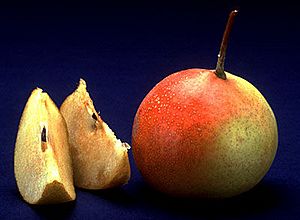Shipova facts for kids
Quick facts for kids Shipova |
|
|---|---|
 |
|
| Scientific classification | |
| Genus: |
× Sorbopyrus
|
| Species: |
irregularis
|
| Synonyms | |
|
|
The shipova (× Sorbopyrus irregularis) is a special kind of tree. It's a hybrid, which means it's a mix of two different parent trees. The shipova comes from the European pear (Pyrus communis) and the common whitebeam (Sorbus aria). It grows to be a small to medium-sized tree, usually between 10 to 18 meters tall. If it's grown on a special root system, it might only reach 4 to 6 meters. Its leaves fall off in autumn, and they are oval-shaped, about 7–11 cm long. The tree produces a small, round fruit called a pome, which is about 2.5–3 cm long. This fruit is safe to eat and has sweet, yellowish flesh. Many people say it tastes a lot like a Nashi pear.
The Shipova's Story
The shipova tree has an interesting past! This hybrid tree first appeared in a place called Bollwiller in Alsace, France. This happened a very long time ago, even before the year 1612. It was first known as the Bollwiller pear.
How Shipova Trees Grow
Most shipova trees you see today were not grown from seeds. Instead, they were grown by a method called grafting. This is when a part of one plant is joined to another plant. Shipova trees are almost sterile, meaning they rarely produce seeds that can grow into new trees. Because of this, they are not grown as widely as other fruit trees.
A Unique Hybrid
The shipova is the only known species in a special group called × Sorbopyrus. This name tells us it's a hybrid genus, a mix between Sorbus (like the whitebeam) and Pyrus (like the pear tree).

